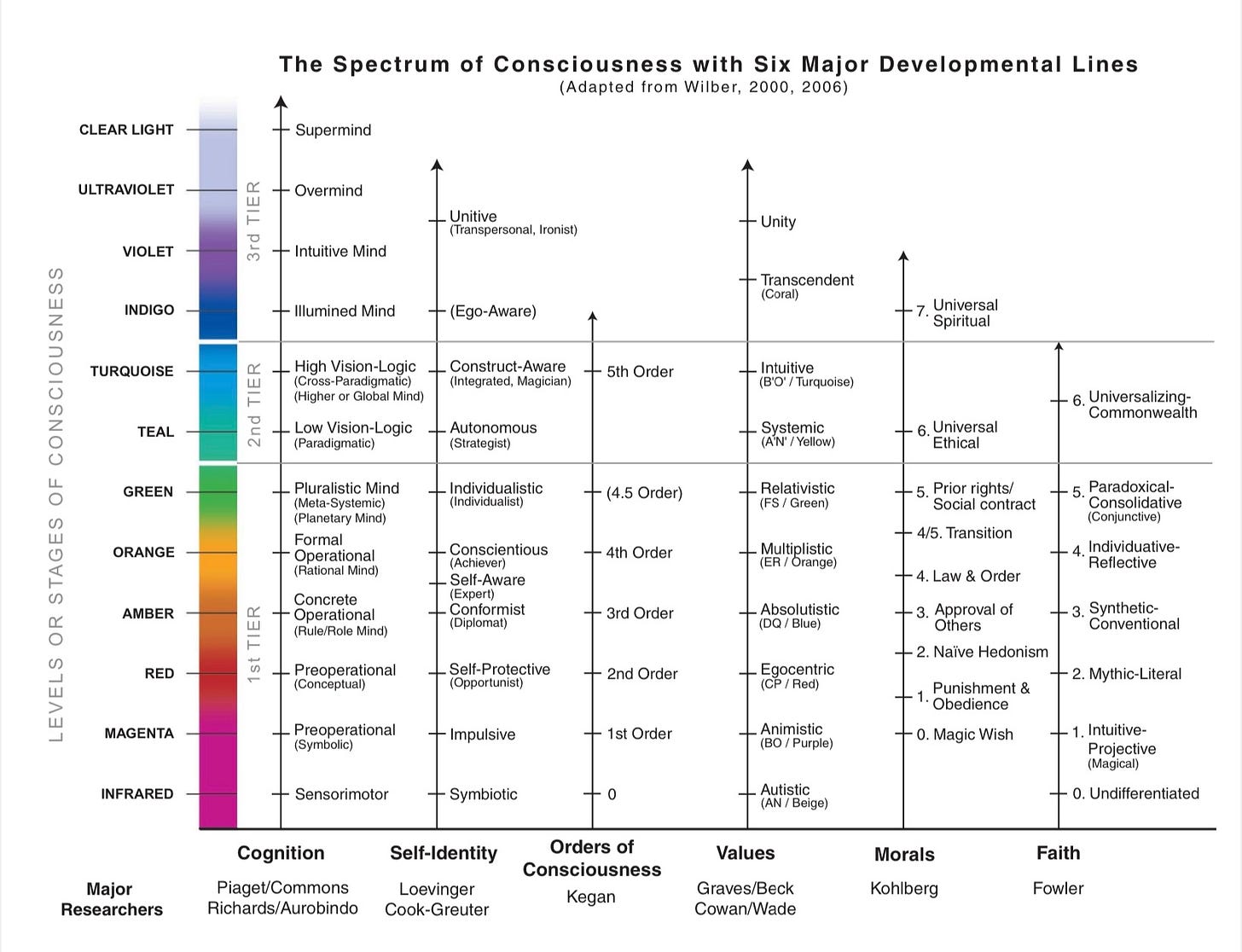Scaling the Peaks of Consciousness: A Deep Dive into Integral Theory and Developmental Lines
Structure development consists of three principal components: the ladder, the climber, and the View. The ladder symbolises the range of fundamental structures of consciousness, which are frequently seen as rungs. These structures are lasting, meaning that once they have materialised, they continue to exist.
The climber is the representation of the self-system or self-sense. It progresses upward along the ladder, temporarily and exclusively aligning itself with the present rung it is situated on. The View is the perspective of the world that the self develops based on its current position on the ladder. Each rung of the ladder delivers a unique View.
The self's identification with certain cognitive stages, or rungs, corresponds to different world views. If the self identifies with the concrete rule/role mind (rung 4), its View becomes ethnocentric, concrete, and mythic-literal. If the self is at the rational mind level (rung 5), the View morphs into a modern, worldcentric, rational, scientific, or objective perspective.
Further progression leads to the pluralistic mind (rung 6), where the View transitions into a postmodern, pluralistic, multicultural perspective. As the self reaches the vision-logic mind (rung 7), it adopts an Integral View of the world.
Each advancement to a higher rung on the ladder allows the self to leave the previous stage, thus forfeiting the preceding View, but gaining a new, elevated perspective. However, all previous rungs continue to exist, embodying the concept of "transcend and include" or "negate and preserve." In other words, the self transcends and negates the previous View as it moves up the ladder, but the structure-rungs themselves remain intact and preserved.
The human mind is a fascinating confluence of various forms of multiple intelligences or developmental lines. These include cognitive intelligence, emotional intelligence, moral intelligence, interpersonal intelligence, intrapersonal intelligence, kinaesthetic intelligence, logico-mathematical intelligence, spiritual intelligence, aesthetic intelligence, and more. Each of these unique intelligences constitutes a different path in human cognitive development, yet they are interconnected in intriguing ways.
Despite their inherent differences, all these developmental lines share common progression milestones. They all pass through the same basic developmental levels, or what we might call structure-rungs. These levels range from the Archaic to the Magic, Magic-Mythic, Mythic, Rational, Pluralistic, Integral, and finally, the Super-Integral. These levels serve as common markers of progress, irrespective of the specific intelligence line being considered.
However, a significant challenge emerges when we attempt to name these developmental levels. The names we choose for these levels should be neutral, not favouring or emphasising any particular developmental line. This requirement stems from the fact that these levels are universal—they apply equally to all developmental lines and multiple intelligences.
An apt analogy to understand this concept is imagining a mountain with twelve different paths leading to the top. Each path represents a different developmental line or multiple intelligence. The views from each path, symbolising the unique characteristics and perspectives of each intelligence, vary greatly. However, there is one common factor to all these paths: their altitude.
Just as altitude serves as an impartial measure of progress up the mountain, a similarly unbiased term should be employed to represent the developmental stages across the different lines of multiple intelligences. The altitude metaphor emphasises that we can equate positions along different paths at the same level of growth, without showing preference to any one path over another.
So, using altitude as an analogy provides us with a concept that can serve as a neutral way to designate the degree of development across various developmental lines. This approach allows for an unbiased comparison and understanding of the diverse intelligences present in the human mind.
The Integral Theory presents a novel way of illustrating the progress of developmental lines, aptly referred to as ‘path altitudes’. These path altitudes encapsulate the degree of development in any line and are represented using colours. The system ingeniously aligns with the order of a natural rainbow, ensuring it remains neutral, not favouring any specific path or View.
These colours are visually demonstrated in the diagram below, providing an intuitive illustration of how far each developmental line has progressed or developed. To ensure clarity for individuals unfamiliar with this colour system, terms like Archaic, Magic, and Mythic among others, have been used as introductory descriptors of these levels.
However, there are alternative terminologies employed by various researchers. Terms such as “opportunistic” for Magic-Mythic, “diplomat” for Mythic, “expert” for Mythic-Rational, or “strategist” for Holistic are used. Nevertheless, these terms may be somewhat misleading, insinuating that these are stages that a typical rational person might navigate through. Yet in reality, each level symbolises profoundly different structures of consciousness.
A recurring error within this field is the tendency to name these stages from a rational-level cognition standpoint, disregarding their pre-rational forms. More accurate terms like “Magic-Mythic” better encapsulate the true nature of these stages compared to others like “opportunistic.”
To visualise these concepts, ‘Integral psychographs’ are employed. These diagrams vertically list the major developmental altitudes or levels, and horizontally plot the various developmental lines, or multiple intelligences. These psychographs offer a comparative view of the levels, structures, or stages (and their corresponding Views) of the various developmental lines.


